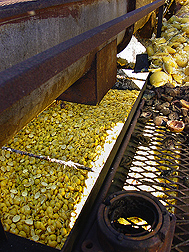|
Read the
magazine
story to find out more. |
|

In the future,
citrus peel waste could be used for ethanol production rather than cattle feed,
its current use. Click the image for more information about
it.
|
Citrus Peel Waste a Potential Source of Ethanol
By Alfredo
Flores April 6, 2006
Thanks to recent hikes in gasoline prices, there is a renewed interest
in finding a cheaper way to fill up the gas tank. Researchers at the
Agricultural Research Service (ARS)
Citrus
and Subtropical Products Laboratory in Winter Haven, Fla. have been working
on a potential substitute: citrus peels.
In 1992, Karel Grohmann, then research leader of the Winter Haven lab,
began researching the feasibility of converting citrus peel waste into fuel
ethanol. Citrus waste materials are rich in pectin, cellulose and hemicellusic
polysaccharides, which can be hydrolyzed into sugars and fermented into
alcohol. Most of this dried peel residue—a total of 1.2 million tons
annually in Florida alone—is currently marketed as low-value cattle feed,
despite its relatively high processing cost.
In 2004,
Bill
Widmer, an ARS chemist at Winter Haven, picked up where Grohmann left off,
with the help of a cooperative research and development agreement partner,
Renewable Spirits LLC of Delray Beach, Fla. Widmer and his scientific team
first modified the process to substantially reduce the amount of enzyme
required to convert the citrus waste carbohydrates to sugars and ethanol. Now
the process shows economic promise for large-volume production.
Beginning with the one-quart-to-one-gallon laboratory process
developed by Grohmann, the process was modified to work at 10-gallon,
100-gallon and 1,000-gallon batch levels. A 10,000-gallon pilot facility is
currently under construction, and should be finished by sometime this year.
With further research, according to Widmer, Florida's citrus peel waste could
yield up to 80 million gallons of ethanol per year.
Read more
about the research in the April issue of Agricultural Research magazine.
ARS is the U.S. Department of
Agriculture's principle scientific research agency.